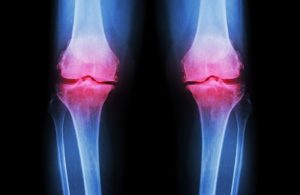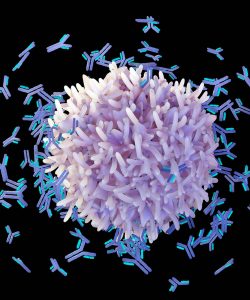In rheumatic diseases, various tissues in the body become inflamed and do not heal on their own. The joints are primarily affected, but also other “hard” structures such as cartilage and bones as well as “soft” tissues such as muscles, ligaments and tendons. In addition, the nerves, blood vessels and almost all organs can also be damaged. The permanent inflammation causes the affected areas to hurt and the joints become less mobile over time.
However, the symptoms and causes can vary greatly. Doctors therefore divide rheumatic diseases into groups with similar symptoms.
When the body attacks itself
One of the most common forms of rheumatism in Germany is rheumatoid arthritis. This is an inflammatory rheumatic autoimmune disease in which the immune system mistakenly attacks the body’s own tissue, causing it to become inflamed. Certain immune cells, the lymphocytes, which actually specifically recognize and attack foreign structures, are probably significantly involved. However, in rheumatism, these immune cells function incorrectly, as a study with pregnant women shows. In the test subjects with rheumatoid arthritis, the number of lymphocytes in the blood decreased during pregnancy. As a result, “the symptoms subsided or even disappeared,” reports Peter Villiger from the Inselspital Bern.
But how does this dysregulation of the immune cells come about? The trigger is probably certain messenger substances from the group of interleukins, which are increasingly present in the affected joints. Various factors can contribute to the creation of these messenger substances. “Autoimmunity has various possible causes such as bacterial or viral infections, drugs, toxins, disorders of immune regulation and genetic predispositions,” says the Swiss Rheumatism League.
But there are apparently also proteins that can prevent the damaging effects of interleukins, as researchers have discovered. Based on that, they are currently developing one Vaccine against rheumatoid arthritis (doi: 10.1073/pnas.2025257118). To date there are no vaccinations against this or other types of rheumatism.
Symmetrically swollen joints
Due to the malfunction, the immune system of rheumatism patients attacks the inner skin of joints, tendon sheaths or bursa, which becomes more and more scarred over time. This can happen on the hands, feet, knees, shoulders or even hips. As it progresses, the cartilage and ligaments of these joints can also become damaged. “The chronic inflammation severely limits the function of the affected joints and can completely destroy them in the long term,” explains the Swiss Rheumatism League. This not only hurts, but also significantly limits the patient’s mobility. Rheumatoid arthritis is characterized by pain and swelling in symmetrical tissues – for example, the same finger joints on both hands.
There are also other rheumatic-inflammatory autoimmune diseases. An example is Bechterew’s disease, in which a special recognition factor in the immune system is altered. As a result, the immune system specifically attacks the joints and ligaments of the spine. If left untreated, a hump will result. In rarer forms of autoimmune rheumatism, entire organs instead of joints are affected, for example in “collagenoses” such as systemic lupus erythematosus.

Osteoarthritis: when the cartilage wears out
Other rheumatic joint diseases such as osteoarthritis are caused by the wear and tear of joint cartilage, which becomes thinner over time until bone rubs against bone. This happens naturally with age, but can also occur at a young age in osteoarthritis patients and cannot be reversed. According to the German Arthrosis Foundation, the most common causes are overload, misalignments or injuries. But a genetic predisposition is also considered likely.
In the case of arthrosis and the like, painful inflammation in the joints can also occur as a result of wear and tear, but these are not the trigger and driver of the disease. In contrast to inflammatory rheumatic autoimmune diseases, inflammation is common in osteoarthritis, but not necessarily so. What is more characteristic is the progressive loss of cartilage.

Gout and other metabolic diseases
Some metabolic disorders can also cause rheumatism symptoms. These types of rheumatism are triggered by metabolic products that are not broken down or excreted properly by the affected person’s body, so that they accumulate.
The best-known example is gout, in which uric acid accumulates in the blood. In the similarly common pseudogout, also called chondrocalcinosis, it is the pyrophosphate. Both metabolic molecules are deposited as crystals in the joints and connective tissue and thus cause the painful inflammation typical of rheumatism. These diseases can be genetic or caused by an unhealthy lifestyle. A combination of both factors is also possible.
Soft tissue rheumatism
Another type of rheumatic disease does not affect the joints, but rather soft tissues such as muscles and tendons. It is also accompanied by chronic pain, stiff body parts and fatigue. In this case, the trigger is not inflammation, but rather impaired pain perception and processing in the brain.
A prominent example is fibromyalgia, also known as soft tissue or muscular rheumatism. As researchers discovered, small pain-conducting nerve fibers in the skin are damaged. “In all (…) test procedures, clear signs of damage to the small nerve fibers were found in patients with fibromyalgia syndrome,” reports Nurcan Üçeyler from the University of Würzburg. The exact causes and risk factors for this disease are not known, but genetic and other factors are also suspected.
March 15, 2024 – Claudia Krapp

